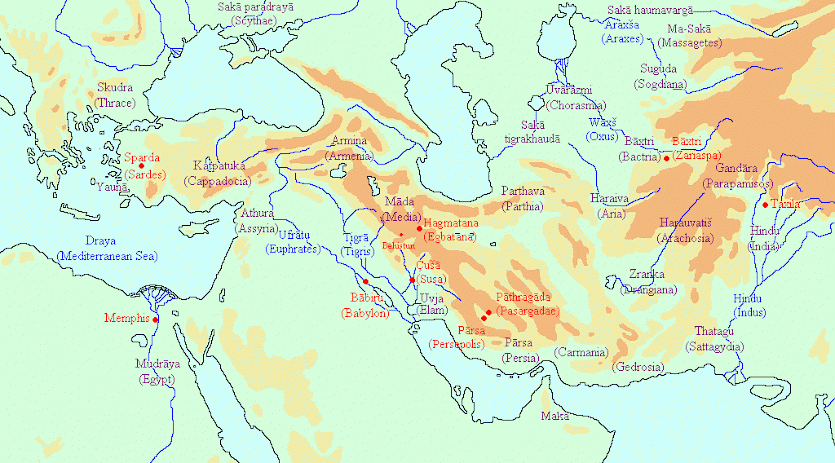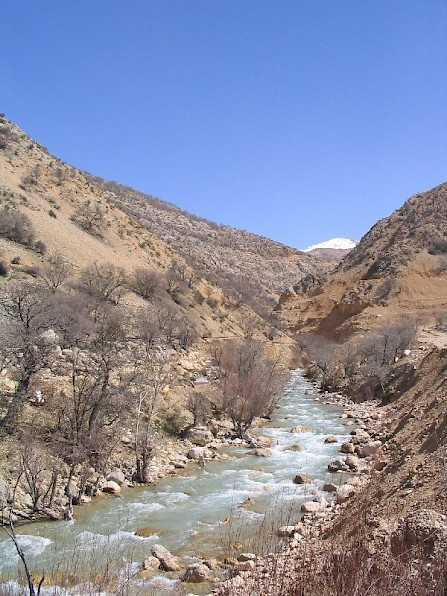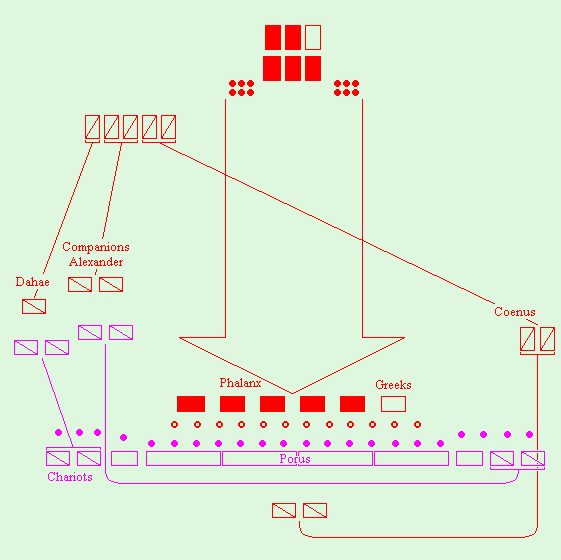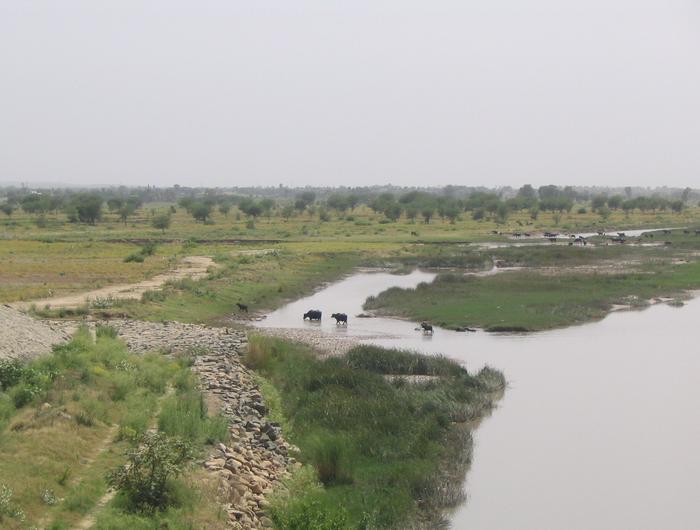Coenus
Coenus (c.360-326): commander in the army of the Macedonian king Alexander the Great.

Coenus was the son of Macedonian nobleman named Polemocrates. He was probably born in Elimeia, the valley of the Haliacmon river, because during Alexander's Persian war, he commanded the Elimian battalion of the Macedonian phalanx. It was probably in this part of Macedonia that he received land from king Philip (360-336). In 335/334 Coenus married a daughter of Parmenion, Philip's best general.
After the murder of Philip, his son Alexander became king. As usual, there were rival kings, but Parmenion ensured the accession of the crown prince. In return, Alexander appointed (or had to appoint) several relatives of Parmenion on important positions, and Coenus was one of them. As we already noticed, he was commander of one of the battalions of the phalanx. In this quality, Coenus was present during all battles of Alexander.
In his accession year (335), Alexander attacked a group of rebels in Illyricum (modern Albania). He used the battalions of Coenus and Perdiccas for a successful nightly attack on the Illyrian camp. This is Coenus' first-known military action, although he must have seen battle before, during the reign of Philip.
In May 334, Alexander launched his famous campaign against Persia. In June, he defeated the local levies of the Persian satraps of Asia Minor on the banks of the Granicus, and Coenus commanded the Elimian battalion. After the conquest of Ionia and Lydia (western Turkey), Alexander sent Coenus back home with soldiers who had recently married and were allowed to spend the winter with their wives. In the spring, Coenus, Ptolemy and Meleager led these men back to Gordium, the capital of Phrygia that had been captured by Parmenion.
Here, Alexander prepared for the march to the east, where he hoped to find and defeat the Persian army, settling the war in a big battle. He was not disappointed: in November 333, his army defeated the army of Darius III Codomannus near Issus (text).
In July 332, Coenus and an otherwise unknown Admetus commanded the first assault wave against the walls of Tyre, the island city that had resisted the Macedonian siege for half a year. Coenus was successful; Admetus died in action.
It is not known whether Coenus was present during Alexander's Egyptian campaign. Phalanx units are not mentioned in the narrative of our best source, Arrian of Nicomedia. However, they played an important role during the battle of Gaugamela (1 October 331). Again, Coenus is mentioned as commander of one of the phalanx battalions. Like Hephaestion, Alexander's closest friend, and Perdiccas, he was almost mortally wounded.

After the conquest of Babylonia, Alexander attacked the Persian heartland. He first had to take the mountain pass that was known as the Persian Gate. Arrian states that Coenus was sent to build a bridge across a nearby bridge; another source, Quintus Curtius Rufus, informs us that he led his battalion in the encircling maneuver that secured the pass (according to Arrian, this was Perdiccas' battalion). We cannot choose between these two options, but since Coenus was wounded only six weeks before, we may assume that Arrian should be preferred.
The phalanx played no important role during the pursuit of Darius III, so Coenus was sent on a foraging mission in Parthia (summer 330). This may be an indication that Coenus was wounded, but if so, it is a bit strange to read that during the war in Hyrcania, he and Alexander attacked a mountain tribe that was known as the Mardians. Not much later, the Macedonian army reached Aria, where Coenus' battalion played an important role in the lightning campaign against the rebel satrap Satibarzanes.
At this stage of Alexander's war in the Achaemenid empire, the commander of the phalanx, Craterus, accused the commander of the Companion cavalry, Parmenion's son Philotas, of high treason. There was some justification to this claim, because Philotas had failed to report a conspiracy against the king. The general feeling among the judges was that Philotas was guilty and ought to be stoned to death, but Craterus, Hephaestion and Coenus believed that Philotas was part of a larger conspiracy, and should first be tortured. As was to be expected, Philotas told many things, but the truth could not be established. In the end, he was executed, and so was his father Parmenion, who was certainly innocent but could no longer be relied upon. Coenus' role in this affair is remarkable, because he was Parmenion's son-in-law, married to Philotas' sister.
In July 329, the Macedonian army marched through Sogdia and reached the river Jaxartes, the modern Syrdar'ya. After some campaigning in this region, Alexander divided his army in five smaller divisions, because this was the only way to cope with the hit-and-run tactics of the native, nomadic population. One division was commanded by Coenus and Artabazus, an important Persian nobleman, the satrap of Bactria and father of Alexander's mistress Barsine. They were under orders to search and destroy the army of a local chief, Spitamenes (Persian Spitâmaneh). Later, Artabazus was pensioned off, and Coenus was left alone, his first sole command. He managed to defeat Spitamenes in a bloody battle, in which, according to Arrian, 8,000 Sogdians and 37 Macedonians were killed. Not much later, Spitamenes was killed by his own men.
In 326, Alexander invaded Gandara, the west of the Punjab. Coenus' battalion played a role during the campaign in the Swat valley and the siege of the Aornus rock. After Alexander's crossing of the Indus by means of a ship bridge that was built by Hephaestion and Perdiccas, Coenus brought the ships to the Hydaspes river (modern Jhelum). The road, which goes up and down, is more or less identical to the present Grand Trunk Road, and was once called Uttarapatha.

They were not used as a bridge, however, but as ferries. On the banks of the Hydaspes, the Macedonian army encountered an Indian army, commanded by king Porus (Indian Puru). During the battle, Coenus commanded a cavalry unit. (Perdiccas made the same switch from infantry to cavalry in India.) The Macedonian cavalry was posted on the right wing, the Indian chariots were on both wings. Therefore, Porus moved his right wing cavalry to the left, leaving one wing unprotected. Coenus saw what happened, and quickly moved to the Indian right, encircling the Indians and attacking them in the rear. It was the decisive charge. At the same time, the Macedonian main cavalry force broke through the Indian chariot units, and made a second encircling movement. To the Indians, the result was disastrous and bloody.

Alexander continued to the east, but when he had arrived at the river Hyphasis (Beas), his men refused to go any further. Alexander was angry, but in the meeting of his officers, Coenus, the hero of the battle at the Hydaspes, convinced the king that it was better to return (text).
Coenus died soon after, in the summer of 326. He received a splendid state funeral. Our sources explicitly state that there were no rumors about poisoning or murder, which strongly suggests that the ancients found it a bit strange that Coenus did not survive his opposition to Alexander.